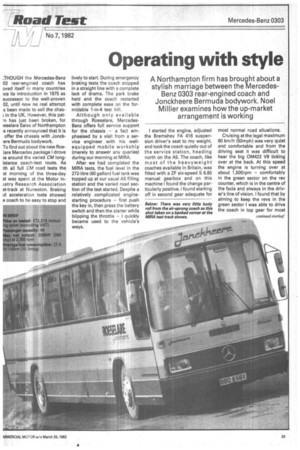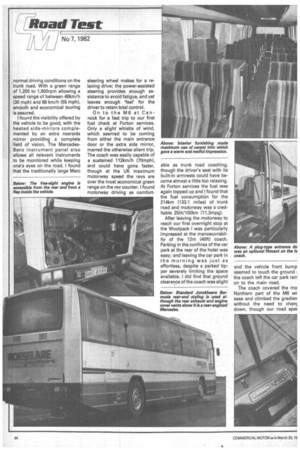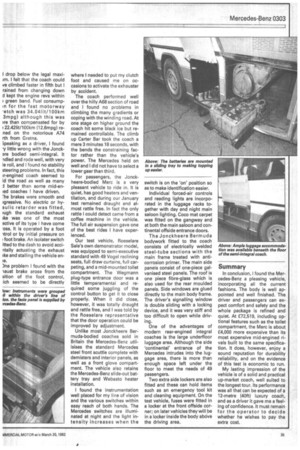Operating with style
Page 29

Page 30

Page 31

If you've noticed an error in this article please click here to report it so we can fix it.
A Northampton firm has brought about a stylish marriage between the MercedesBenz 0303 rear-engined coach and Jonckheere Bermuda bodywork. Noel Millier examines how the up-market arrangement is working
.THOUGH the Mercedes-Benz 03 rear-engined coach has oved itself in many countries ice its introduction in 1975 as successor to the well-proven 02, until now no real attempt s been made to sell the chas; in the UK. However, this pat
ii just been broken, for )eselare Sales of Northampton FS recently announced that it is offer the chassis with Jonck!ere Bermuda bodywork.
To find out about the new Roelare Mercedes package I drove le around the varied CM long'stance coach-test route. As ith all full CM road tests the st morning of the three-day st was spent at the Motor Inistry Research Association st-track at Nuneaton. Braking id acceleration tests showed e coach to be easy to stop and
lively to start. During emergency braking tests the coach stopped in a straight line with a complete lack of drama. The park brake held and the coach restarted with complete ease on the formidable 1-in-4 test hill.
Although only available through Roeselare, MercedesBenz offers full service support for the chassis — a fact emphasised by a visit from a service engineer with his wellequipped mobile workship (merely to answer any queries) during our morning at MIRA.
After we had completed the MIRA tests, the fuel level in the 272-litre (60 gallon) fuel tank was topped up at our usual AS filling station and the varied road section of the test started. Despite a relatively complicated enginestarting procedure — first push the key in, then press the battery switch and then the starter while blipping the throttle — I quickly became used to the vehicle's ways. I started the engine, adjusted the Bremshey FA 416 suspension driver's seat to my weight, and took the coach quietly out of the service station, heading north on the A5. The coach, like most of the heavyweight coaches available in Britain, was fitted with a ZF six-speed S 6.80 manual gearbox and on this machine I found the change particularly positive. I found starting off in second gear adequate for
Below: There was very little body roll from the air-sprung coach as this shot taken on a banked corner at the MIRA test track shows.
most normal road situations.
Cruising at the legal maximum 80 km/h (50mph) was very quiet and comfortable and from the driving seat it was difficult to hear the big 0M422 V8 ticking over at the back. At this speed the engine is turning over at about 1,500rpm — comfortably in the green sector on the rev counter, which is in the centre of the facia and always in the driver's line of vision. I found that by aiming to keep the revs in the green sector I was able to drive the coach in top gear for most normal driving conditions on the trunk road. With a green range of 1,200 to 1,900rpm allowing a speed range of between 413km/h (30 mph) and 88 km/h (55 mph), smooth and economical touring is assured. _ I found the visibility offered by the vehicle to be good, with the heated side-mirrors complemented by an extra nearside mirror providing a complete field of vision. The MercedesBenz instrument panel also allows all relevant instruments to be monitored while keeping one's eyes on the road. I found that the traditionally large Merc steering wheel makes for a relaxing drive; the power-assisted steering provides enough assistance to avoid fatigue, and yet leaves enough 'feel' for the driver to retain total control.
On to the MO at Cannock for a fast trip to our first fuel check at Porton services. Only a slight whistle of wind, which seemed to be coming from either the main entrance door or the extra side mirror, marred the otherwise silent trip. The coach was easily capable of a sustained 112km/h (70mph), and could have gone faster, though at the UK maximum motorway speed the revs are over the most economical green range on the rev counter. I found motorway driving as comfort able as trunk road coaching, though the driver's seat with its built-in armrests could have become almost a little too relaxing. At Porton services the fuel was again topped up and I found that the fuel consumption for the 214km (133.1 miles) of trunk road and motorway was a creditable 251it/100km (11.3mpg).
After leaving the motorway to reach our first overnight stop at the Woolpack I was particularly impressed at the manoeuvrability of the 12m (40ft) coach. Parking in the confines of the car park at the rear of the hotel was easy; and leaving the car park in the morning was just as effortless, despite a parked tipper severely limiting the space available. I did find that ground clearance of the coach was slight and the vehicle front bump seemed to touch the ground the coach left the car park rarr on to the main road.
The coach covered the mo Northern part of the M6 wi ease and climbed the gradien without the need to charm down, though our road spec
I drop below the legal maxian. I felt that the coach could ye climbed faster in fifth but I rained from changing down d kept the engine revs within green band. Fuel consumpin for the fast motorway -etch was 34.0411t/100km 3mpg) although this was ire than compensated for by 22.421it/100km (12.6mpg) rened on the notorious A74 rth from Gretna.
;peaking as a driver, I found y little wrong with the Jonckare bodied semi-integral. ft idled and rode well, with very le roll, and I found no stability steering problems. In fact, this ir-engined coach seemed to Id the road as well as many d better than some mid-enied coaches I have driven. he brakes were smooth and )gressive. No electric or hyaulic retarder was fitted, iugh the standard exhaust ike was one of the most active of its type I have come 'oss. It is operated by a foot itrol or by initial pressure on !foot brake. An isolater switch itted to the dash to avoid acciitally actuating the exhaust ike and stalling the vehicle ene.
)ne problem I found with the laust brake arose from the sition of the foot control, ich seemed to be directly where I needed to put my clutch foot and caused me on occasions to activate the exhauster by accident.
The coach performed well over the hilly A68 section of road and I found no problems in climbing the many gradients or coping with the winding road. At one stage on higher ground the coach hit some black ice but remained controllable. The climb up Carter Bar took the coach a mere 3 minutes 18 seconds, with the bends the constraining factor rather than the vehicle's power. The Mercedes held on well and I did not have to select a lower gear than third.
For passengers, the Jonckheere-bodied Merc is a very pleasant vehicle to ride in. It is quiet, has good heaters and ventilation, and during our January test remained draught and almost rattle free. In fact the only rattle I could detect came from a coffee machine in the vehicle. The full air suspension gave one of the best rides I have experienced.
Our test vehicle, Roeselare Sale's own demonstrator model, was equipped to semi-executive standard with 49 Vogel reclining seats, full draw curtains, full carpeting, and a mid-mounted toilet compartment. The Wegmann plug-type entrance door was a little temperamental and required some juggling of the control button to get it to close properly. When it did close, 'however, it was totally draught and rattle free, and I was told by the Roeselare representative that the door operation could be improved by adjustment.
Unlike most Jonckheere Bermuda-bodied coaches sold in Britain the Mercedes-Benz utilisises the standard Mercedes steel front scuttle complete with demisters and interior panels, as well as a front glove compartment. The vehicle also retains the Mercedes-Benz slide-out battery tray and Webasto heater installation.
I found the instrumentation well placed for my line of vision and the various switches within easy reach of both hands. The Mercedes switches are illuminated at night and the light intensity increases when the switch is on the 'on' position so as to make identification easier.
Individual forced-air controls and reading lights are incorporated in the luggage racks together with day and night main saloon lighting. Coco mat carpet was fitted on the gangway and at both the main saloon and continental offside entrance doors.
The Jonckheere Bermuda bodywork fitted to the coach consists of electrically welded steel-tube sections with the main frame treated with anticorrosion primer. The main side panels consist of one-piece galvanised steel panels. The roof is one piece fibre-glass which is also used for the rear moulded panels. Side windows are glued directly to the main body frame. The driver's signalling window is double sliding with a locking device, and it was very stiff and too difficult to open while driving.
One of the advantages of modern rear-engined integral coaches is the large underfloor luggage area. Although the side 'continental' entrance of the Mercedes intrudes into the luggage area, there is more than enough space left under the floor to meet the needs of 49 passengers.
Two extra side lockers are also fitted and these can hold items such as an emergency tool kit and cleaning equipment. On the test vehicle, fuses were fitted in a locker at the front offside corner; on later vehicles they will be in a locker inside the body above the driving area. Summary In conclusion, I found the Mercedes-Benz a pleasing vehicle, incorporating all the current fashions. The body is well appointed and well finished. The driver and passengers can expect comfort and safety and the whole package is refined and quiet. At £72,519, including optional features such as the toilet compartment, the Merc is about £4,000 more expensive than its most expensive mid-engined rivals built to the same specification. It does, however, enjoy a sound reputation for durability reliability, and on the evidence of this test is economic to run.
My lasting impression of the vehicle is of a solid and practical up-market coach, well suited to the longest tour. Its performance was all that can be expected of a 12-metre (40ft) luxury coach, and as a driver it gave me a feeling of confidence. It must remain for the operator to decide whether he wishes to pay the extra cost.
















































